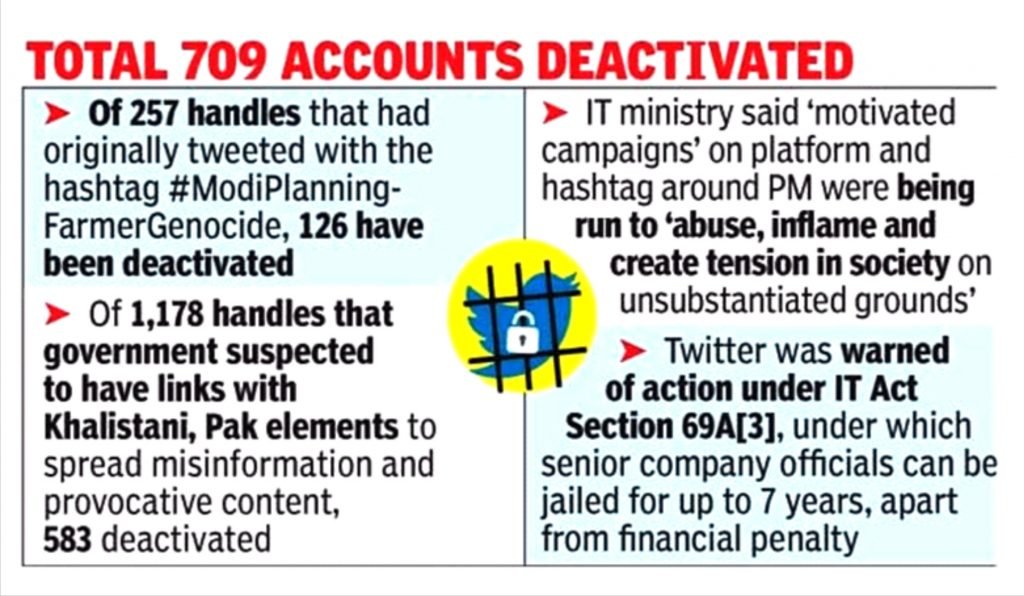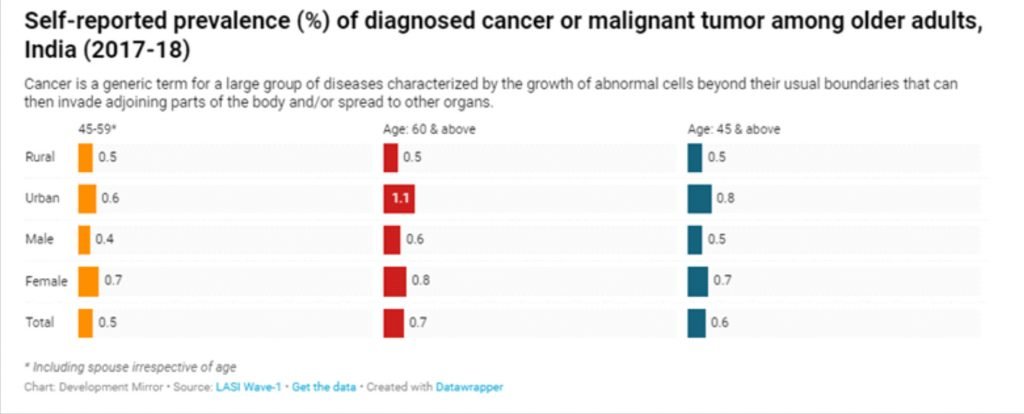Current Affairs (13th February 2021)
CENTRE VS TWITTER
CONTEXT:
- The government and Twitter are at loggerheads over issues related to content removal and freedom of expression, the Centre expressed “deep disappointment” over Twitter’s partial compliance to its orders “grudgingly” and with substantial delay.

About:
- Popular microblogging platform Twitter has come under increasing criticism from several governments across the world over its judgment in allowing or blocking content on its platform.
- The government wants the platform (Twitter) to comply with its earlier order of 31st January, 2021 by which it was asked to block accounts and a controversial hashtag that spoke of an impending ‘genocide’ of farmers for allegedly promoting misinformation about the protests, adversely affecting public order.
- The micro-blogging site reinstated the accounts and tweets on its own and later refused to go back on the decision, contending that it found no violation of its policy.
INITIATIVES OF TECHNOLOGY
CONTEXT:
- Two new initiatives of Technology Information, Forecasting and Assessment Council (TIFAC) —SAKSHAM (Shramik Shakti Manch)- a dynamic job portal for mapping the skills of Shramiks vis-à-vis requirements of MSMEs were launched on the occasion of the 34th Foundation Day celebrations.
About:
- It aimed to directly connect Shramiks with MSMEs and facilitate placement of 10 lakh blue-collar jobs and a Seaweed Mission for commercial farming of seaweeds and its processing for value addition towards boosting national economy
- It is imperative to focus on technologies that can make India self-reliant or Atmanirbhar and are futuristic as well.
- India should identify those areas where technologies have made breakthrough and bring in indigenous technologies to be independent and globally competent.
- It is important to make sure India have an eye on the future as well as on the present, and that is where TIFAC’s role comes in a big way.
- The SAKSHAM job portal will help eliminate middlemen/labour contractor as well as help identification of skill proficiency level and development of Skill Cards for Shramiks.
- Two reports prepared by TIFAC — ‘Techno-economic feasibility on Indian bamboo as Wood Substitute’ and ‘Opportunities for Fruit and Vegetable Processing in North Eastern region of India’ were also launched.
Features of SAKSHAM:
- A dynamic job portal – opportunity for Shramiks and MSMEs
- Facilitate creation of 10 lakh blue collar jobs
- Direct connect between Shramiks and MSMEs, no middleman in between
- Minimise migration of Shramiks – job opportunity in proximate MSMEs
Seaweeds Mission
- It has been launched for commercial farming of seaweeds and its processing for value addition towards boosting the national economy.
The Mission envisages the following activities:
- Establishing model demonstration farms over one hectare for cultivation of economically important seaweeds in nearshore and onshore along the Indian coast
- Establishment of seaweed nurseries for supplying seed material for large scale farming of economically important seaweeds in the country
- Establishment and demonstration of processing technologies/recipes for edible seaweeds in line with consumer acceptability or cultural food habits
- An activity on seaweed cluster development including value chain development, supply chain development, collection of data on environmental, economic and social impacts of seaweed projects in the country.
No better scheme than NREGS
CONTEXT:
- A parliamentary standing committee tabled its report on ‘Social Security and Welfare Measures for Inter-State Migrant Workers’ in Lok Sabha and
- Commenting on the National Rural Employment Guarantee Scheme, in has said that there is no “better scheme” to provide “sustainable livelihood” to unskilled workers.
ABOUT:
- The Standing Committee is of the firm opinion that there is no better Scheme than the MGNREGS to provide sustainable livelihood to the unskilled workers including the inter-state migrant labourers.
- In fact, by enacting the MGNREGA Law in 2005, the Indian Parliament had set in motion a process that provides for a specific and significant welfare provision, constitutive of the very idea of citizenship.
MGNREGA:
- Introduced as a social measure and labor law that guarantees “the right to work”.
- Key tenet : the local government will have to legally provide at least 100 days of wage employment in rural India to enhance their quality of life.
Key objectives:
- Generation of paid rural employment of not less than 100 days for each worker who volunteers for unskilled labour.
- Proactively ensuring social inclusion by strengthening livelihood base of rural poor.
- Creation of durable assets in rural areas such as wells, ponds, roads and canals.
- Reduce urban migration from rural areas.
- Create rural infrastructure by using untapped rural labour.
End hunger
CONTEXT:
- The first-ever voluntary guidelines on food systems and nutrition meant to end hunger and malnutrition were endorsed by members of the Committee on World Food Security (CFS).
ABOUT:
- CFS is an international and intergovernmental platform for stakeholders to work towards ensuring food security and nutrition for all.
- It is hosted and co-funded by the United Nations Food and Agriculture Organization.
- The guidelines have been developed to support countries in their efforts to eradicate all forms of hunger and malnutrition by utilising a comprehensive food systems approach, according to the document released on the occasion.

- The guidelines are intended to build upon and complement the work and mandate of other international bodies, for example the UN Decade of Action on Nutrition (2016-2025).
- They call for realisation of the right to adequate food in the context of national food security for all, particularly for the most vulnerable and affected groups.
- They focus on policy planning and governance so that food systems can be made more resilient and responsive and are in accordance with needs of consumers and producers too, especially small and marginal farmers.
- Governments have been asked to refrain from promulgating and applying any unilateral economic, financial or trade measures that impede the full achievement of economic and social development, while implementing the guidelines.
- The next step — the guidelines’ uptake and implementation at the regional, national and local level — would be even more important and challenging.
Cancer among elderly women
CONTEXT:
- Every 20th Indian family has a history of cancer, according to a recent report released by Longitudinal Aging Study in India (LASI), a longitudinal survey to examine aging and retirement among India’s population aged 45 and above.
ABOUT:
- Cancers are caused by mutations that may be inherited, induced by environmental factors, or result from Deoxyribonucleic acid (DNA) replication errors.
- Aging is the among the main risk factors for carcinogenesis in human beings.
- The first LASI report that surveyed over 72,000 elderly Indians between April 2017 and December 2018 showed that 0.5 per cent of people aged between 45 and 59 self-reported prevalence of diagnosed cancer or malignant tumour.
- This number increased to 0.7 per cent when people aged 60 and above were included.

URBAN OR RURAL:
- Cancer is more prevalent in urban areas compared to rural India, with 0.6 per cent cases among people aged between 45 and 59 being diagnosed with cancer or other malignant tumours.
- But this difference more than doubles in case of adults aged 60 and above, with 1.1 per cent cases in urban areas compared to 0.5 per cent in rural.
- There was not any consistent trend in cancer prevalence based on broad geographical regions in India.
- Himachal Pradesh: highest self-reported prevalence of cancer and other malignant tumours in adults aged 45 and above (2.2 per cent).This number rose to 2.9 per cent in case of senior citizens (60 and above).
- Kerala : 1.8 per cent cases in elderly and 1.6 per cent among all adults.
- Tamil Nadu: least prevalence of diagnosed cancer cases among bigger states with 0.1 per cent found in elderly aged 60 and above.
- Nagaland: lowest number of diagnosed cancer followed by Bihar with 0.2 per cent and 0.1 per cent respectively.
Fossil fuel combustion
CONTEXT:
- Air pollution and higher particulate matter 2.5 concentrations in ambient air originating from fossil fuel combustion caused 2.5 million premature deaths in India in 2018, according to a new research.
ABOUT:
- While other studies, including the Global Burden of Disease report, quantifies the health impacts of PM 2.5, the recent research demarcates between PM2.5 pollutants generated via fossil fuel combustion and those from dust and biogenically sourced particles.
Numbers for India are staggering. This has two major caveats:
- The pollution levels used for the simulation are that of 2012 levels. India’s pollution levels have steadily risen between 2012 and 2018 in most cities. Therefore, the actual number of premature deaths is probably higher.
- All numbers are for 2018. Despite a country-wide lockdown in 2020, pollution levels have been higher than most years. So, if real-time pollution data were to be used, the number of deaths would be higher.
STEPS TAKEN BY INDIA:
- To impose control on pollution sources, including the National Clean Air Programme (NCAP), there is no evidence yet of significant reduction in pollution levels across the cities. Most importantly, there has been very little progress on our use of fossil fuels, primarily coal.
CONCLUSION:
- The human cost of both air pollution and climate change are primarily due to only one factor: Fossil fuel combustion. If all fossil fuel emissions from anthropogenic sources could be potentially controlled, the average life expectancy of the global population would increase by more than one year.
- The transition to cleaner and alternative sources of energy has to be engineered faster, by policy makers and stakeholders.


